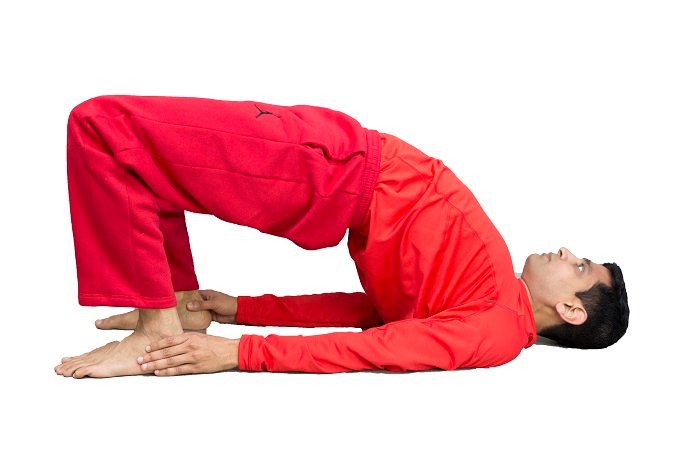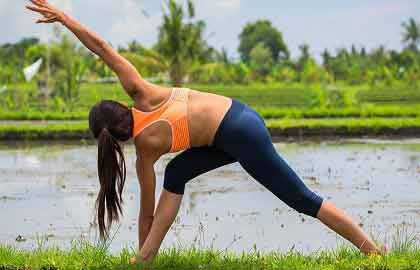Bridge Pose (Setu Bandhasana)

Bridge Pose or Setu Bandhasana is a fantastic basic backbend which is a versatile pose to strengthen your back and help achieve proper alignment. Setu Bandhasana is a beginning backbend that helps to open the chest and stretch the thighs. Energetically, Bridge Pose is an excellent grounding pose and awakens the Root Chakra, stimulates the Thyroid and Throat Chakra and Opens the chest and the Heart Chakra.
Just like the same yoga pose has different names there are also a number of ways to practice the same pose. Bridge pose, (Setu bandha Sarvangasana) is one yoga pose you can do unsupported or supported by props to help you achieve different results.
Meaning of Bridge Pose (Setu Bandhasana)
Its Sanskrit name comes from three different words: setu = bridge, bandha = building or lock, asana = pose
How to pronounce Setu Bandhasana
It is pronounced as SAY-too BAHN-duh-AHS-uh-nuh.
Glimpses
Level: Basic
Duration: 30-60 seconds
Benefits: This asana increases lower body strength, builds core, energizes the body, strengthens and lengthens the spine, and stimulates the nervous system and the endocrine.
Improves: Blood circulation in the back area
Precautions Before Practicing Bridge Pose (Setu Bandhasana)
If you have a neck injury then you should avoid practicing this pose unless you have expert supervision as you could do yourself more damage. Also if you are new to this pose it is important to avoid pulling the shoulders away from the ears as this can over stretch the neck.
Anatomical Focus on Bridge Pose (Setu Bandhasana)
Back, hamstrings, abdomen, buttocks, thighs, calves
How to Practice Bridge Pose (Setu Bandhasana)
- Step 1: Begin the pose by lying flat on your back with your legs outstretched and your arms by your sides. If you have any problems with your neck you might want to support it by placing a blanket under your shoulders. Bend your knees and place your feet flat on the floor. Bring your heels as close to your sitting bones as possible.
- Step 2: As you breathe out, press your inner arms and feet against the floor, and also elevate your bottom. You should firm the bottom but not harden it. Make sure your thighs are parallel to your inner feet. Place your arms under your pelvis and extend through the arms to rest on the shoulder top.
- Step 3: Lift your bottom higher so that the thighs remain parallel to the floor and the knees are over the heels. You should make sure you push the knees forward away from the hips and lengthen the tailbone towards the knees.
- Step 4: Lift your chin so that you move it away from the chest and firm the shoulder blades against the back. At the same time, you should press the sternum towards the chin. Firming your outer arms you should broaden the shoulder blades and lift the space between them at the base of the neck up into the torso.
- Step 5: Remain in the pose for 30 – 60 seconds and then you should roll your spine gently down on to the floor with an exhalation.
Tips for Convenience
- Use a yoga block under the hips to support your weight.
Instructor’s Role in Bridge Pose (Setu Bandhasana)
Seeking guidance from a skilled yoga instructor is highly paramount. They know how to instruct you in such a way as to not push you too far. An incorrectly done yoga pose can cause harm– they will help you from not getting injured.
Benefits of Bridge Pose (Setu Bandhasana)
- This pose will help to stretch out the chest, neck, and spine and stimulate the abdominal organs, lungs, and This means that it can help to rejuvenate tired legs and to improve your digestion.
- One of the biggest advantages of this pose is that it can calm the brain which makes it very useful for stress and mild depression.
- In addition, it can help to relieve menopause symptoms as well as menstrual cramps.
- The pose can be useful at reducing anxiety, fatigue, backache, headaches, and insomnia.
- Finally, it is also useful for conditions such as asthma, high blood pressure, osteoporosis, and sinusitis.
Benefits for Women on Practicing Bridge Pose (Setu Bandhasana)
- Calms mind
- Reduces period pain
- Balances menstrual cycle
- Removes pelvic congestion
- Controls blood circulation
Therapeutic Applications of Bridge Pose (Setu Bandhasana)
- Kidney problems
- Digestion problems
- Diabetes
- Menstrual disorders
- Bronchitis
- Colitis
- Infertility
- Sinusitis
Variations of Bridge Pose (Setu Bandhasana)
- Interlace the hands together behind your back, walk the shoulders in and press down with the arms and shoulders.
- One variation on this pose to increase the intensity can be done by bringing the right knee in against the body on an exhalation. Then as you inhale extend the leg perpendicular to the floor, hold for 30 seconds and then as you exhale return it to the floor and repeat with the other leg. You can deepen the pose by lifting the heels off the floor and pushing your tailbone closer the pubis. Leaving your tailbone where it lowers your heels back to the floor.
The Science behind Bridge Pose (Setu Bandhasana)
The Bridge pose helps to improve flexibility and strength in your spine. It also helps to build up the strength in the legs to support the bending of the back in all back-bending postures. The positioning of the body stimulates abdominal organs and opens up the colon which aid digestion.
Preparatory Pose
- Supta Baddha Konasana (Supine Bound Angle)
- Jathara Parivartanasana (Belly Twist)
- Ardha Sarvangasana (Half Shoulderstand)
Follow-up Pose
- Pavanamuktasana (Wind Relieving pose)
- AnandaBalasana (Joyful Baby)
- Halasana(Plow)
- Sarvangasana(Shoulderstand)













